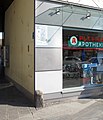Guard stone

A guard stone, jostle stone or chasse-roue (French lit. "wheel chaser"), is a projecting metal, concrete, or stone exterior architectural element located at the corner and/or foot of gates, portes-cochères, garage entries, and walls to prevent damage from vehicle tires and wheels.
Description
Guard stones were developed as an item of street furniture during the era of horse-drawn vehicles, but some are still in use today. They are sometimes used as traffic bollards, but are generally positioned to protect a specific object, such as a corner of a building or the side of a gate. In Paris, they are usually metal in the shape of an arc, ball or cone. There are also models in hard stone with a sloping back to guide errant wheels away from impacting a building.[1] Guard stones made of stone were sometimes surrounded by a metal ring to reduce wear.
The wheels, including the hub, of horse-drawn vehicles protrude beyond the vehicle's body, and are thus prone to collide with and damage a corner of a building or gate. Today, early guard stones are considered cultural heritage objects and some countries, such as France and Belgium, even protect them under specific heritage regulations.[2]
In cities the older guard stones as a concept have been replaced by objects meant for automobile traffic, such as curbs and guard rails. As a city maintenance object they slowly became obsolete and were discarded or reused for other city purposes. When they were incorporated as part of a building's structure however, they were difficult to remove and many remain as silent witnesses to early traffic on historic roads. Today such objects are treasured for historic reasons and are often protected as part of a city's cultural heritage.
Applications
- Farmyard entry doors, subject to traffic by heavy horse-drawn carts.
- Wall corners at the intersection of two city streets (without pavements). In this case, they were often built into the wall.
- Guard stones made in Haussmann's renovation of Paris.
- Turns in rural roads or along parapets of bridges.
- At turns or at intervals on a mountainous ascent. These also allowed helped the coachman to keep the vehicle from rolling backwards, while it paused to let the horses catch their breath.
Gallery
-
 Farmyard doorway with guard stones in Belgium
Farmyard doorway with guard stones in Belgium -
 Guard stone beneath porte-cochère at the Burleigh-Davidson building, the Berwick Academy, South Berwick, Maine
Guard stone beneath porte-cochère at the Burleigh-Davidson building, the Berwick Academy, South Berwick, Maine - A guard stone in Kitzingen, Germany
-
 Guard-stone in Angoulême, France
Guard-stone in Angoulême, France - Corner chasse-roue in Paris
-
 Haussmannian guard stone
Haussmannian guard stone -
 Passage Saint-Paul, Paris
Passage Saint-Paul, Paris -
 In Germany, this traffic bollard has made the surrounding guard stones redundant
In Germany, this traffic bollard has made the surrounding guard stones redundant -
 Deflecting stone in Northern Ireland
Deflecting stone in Northern Ireland -
 Gate with guard stone in Trier, Germany
Gate with guard stone in Trier, Germany -
 Guard stone still in place at a modern façade in Nuremberg city centre
Guard stone still in place at a modern façade in Nuremberg city centre
Notes
External links

- Images of various models of guard stones
- Irish Examiner article related to jostle stone injury, January 2020



















